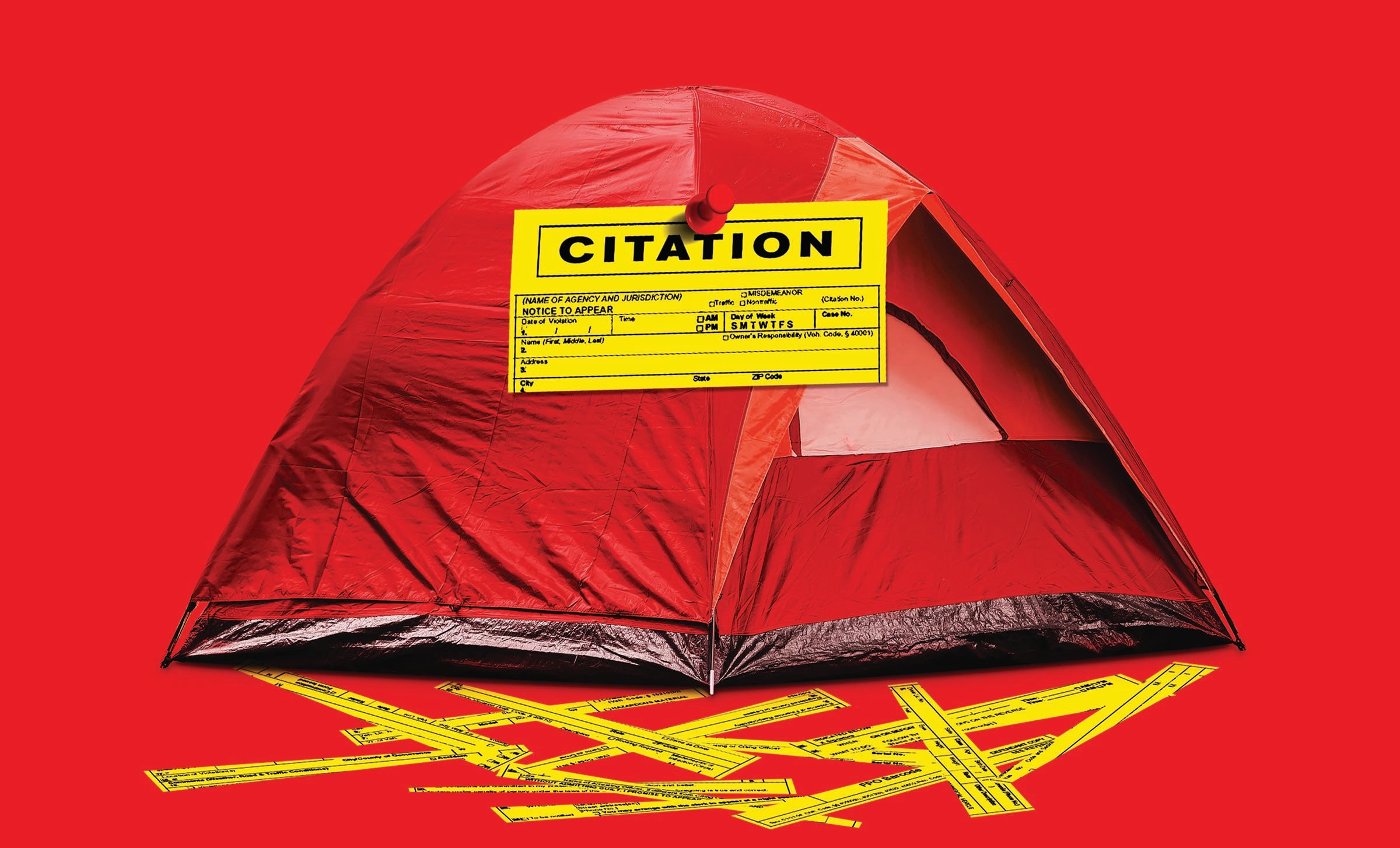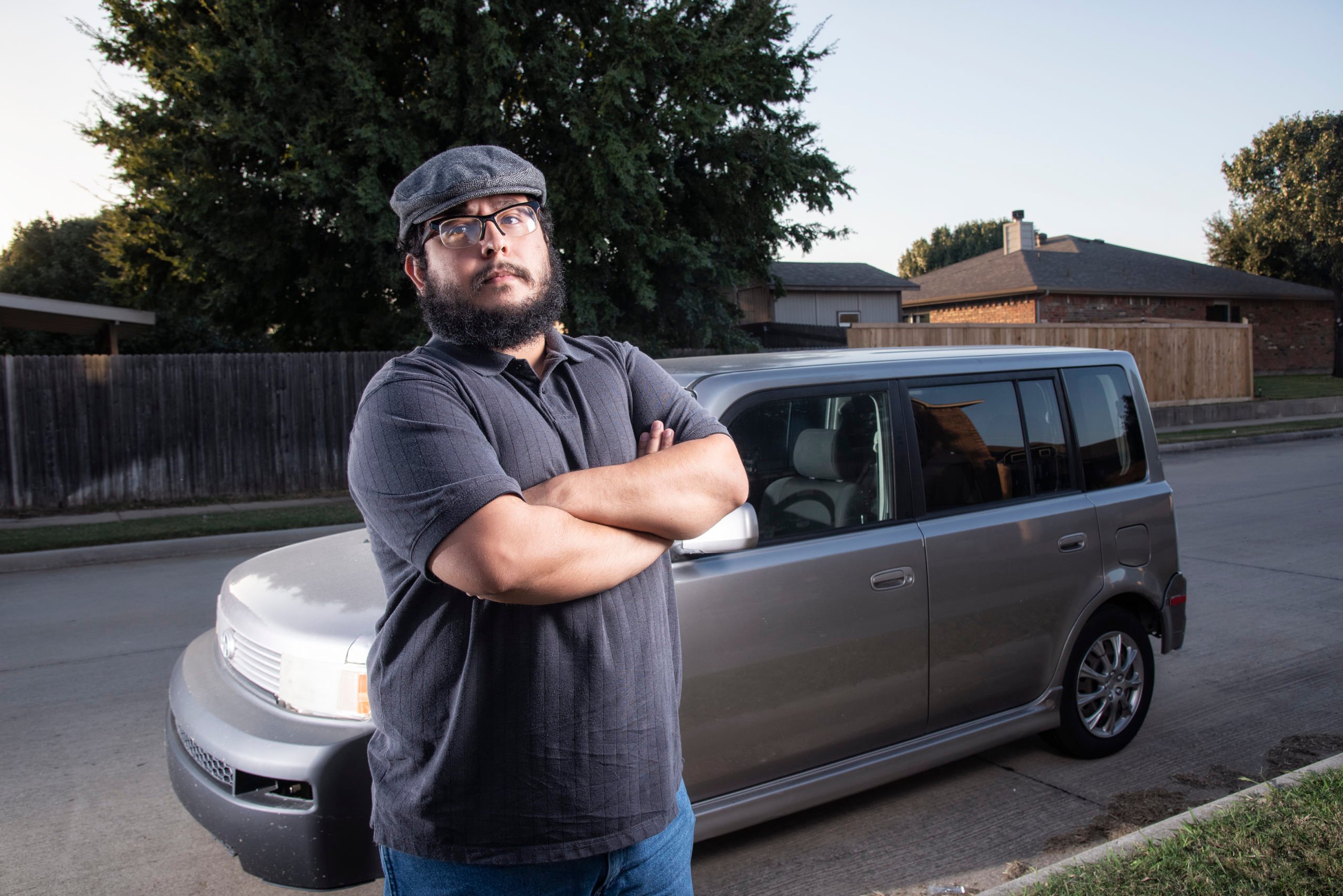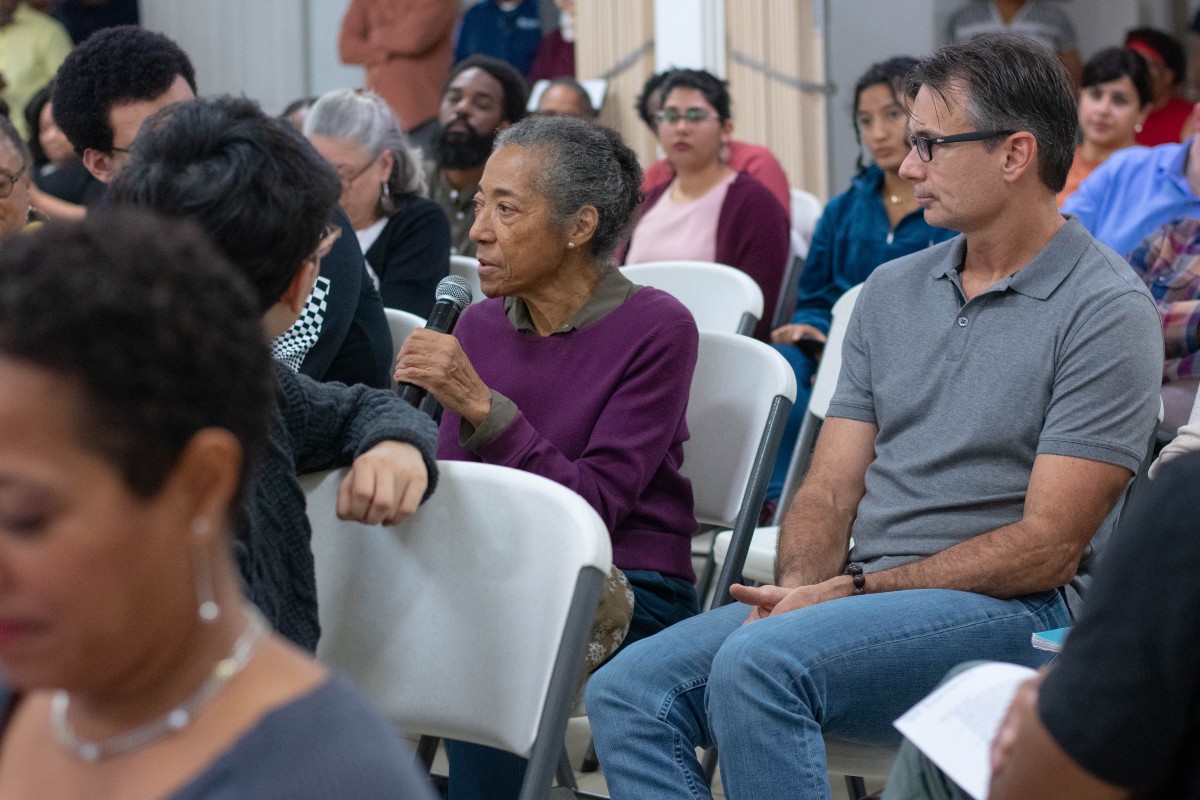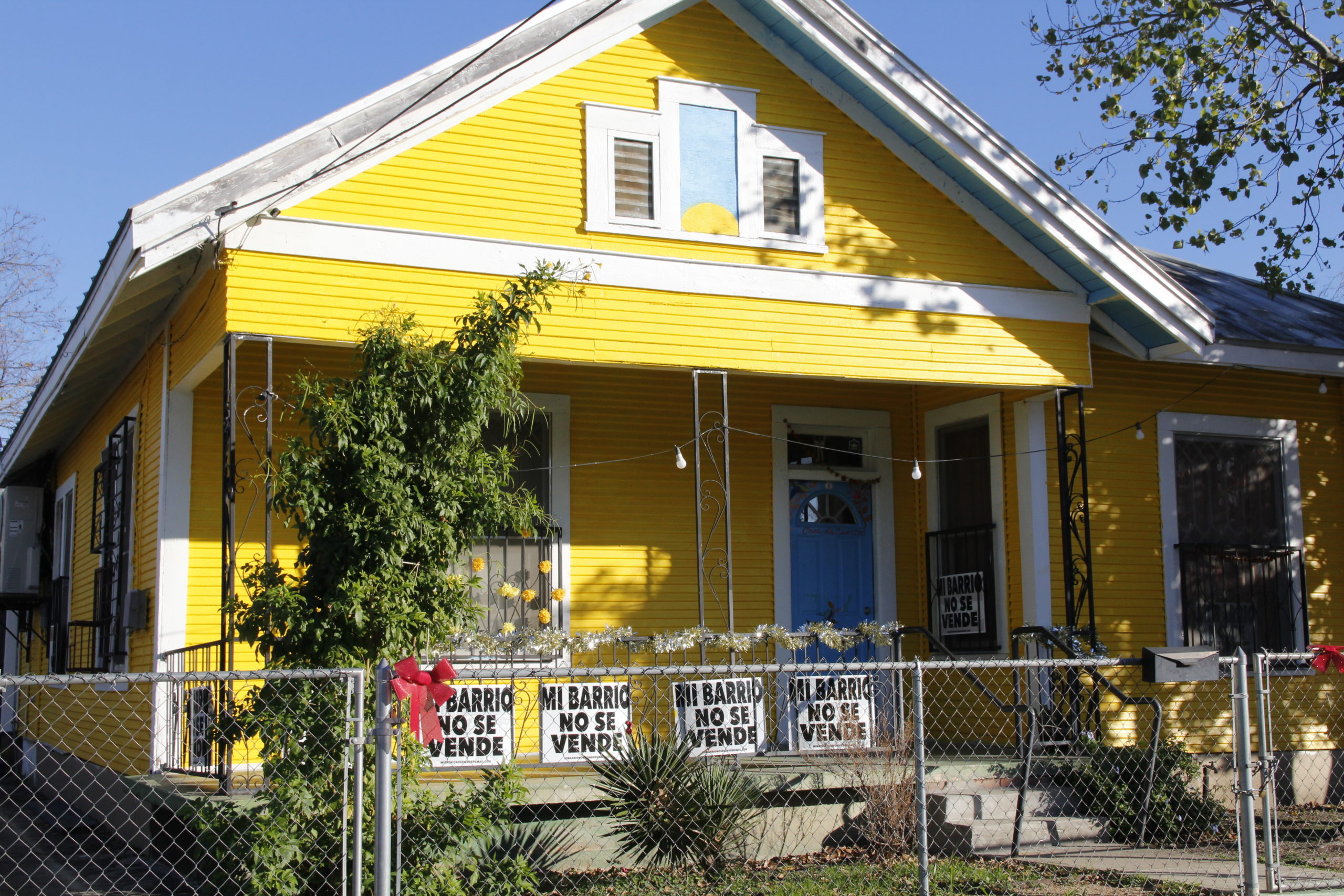
In San Antonio, a Fight over Public Housing Heats Up
The fate of the Alamo City’s oldest and largest public housing development is fueling a conflict between San Antonians with different visions for the future of the city’s West Side.

Above: The Esperanza Peace and Justice Center runs a meeting space and arts cooperative next to the Alazán-Apache housing development. The Center and its allies would like to see the courts rehabilitated and kept largely intact.
Update: On January 21, the board of the San Antonio Housing Authority announced dramatic changes to its plans for the Alazán-Apache Courts, including that the agency has cancelled its proposed partnership with the private developer NRP Group. As it proceeds with redeveloping the project, the agency says, it now has new goals including keeping “all residents within Alazán” and “maintaining or growing” the number of public housing units at the Alazán-Apache site. Community activists cheered the changes.
On a Thursday in early November, nearly 70 San Antonians showed up via Zoom to address the board of the San Antonio Housing Authority (SAHA), a quasi-governmental agency that oversees the city’s public housing and Section 8 vouchers. Due to the unusual volume of people, the board chair cut individuals’ speaking time from 3 minutes to a minute and a half. In 90-second bursts, often interrupted by technical difficulties, a stream of community activists, academics, and public housing tenants commented on SAHA’s plans to demolish and redevelop the Alazán-Apache Courts, San Antonio’s oldest and largest public housing development, with most opposing the plan.
“This is [our] last big public housing development and when it’s gone, it’s gone forever,” said Sofía López, a housing justice activist who served on the SAHA board until last fall and opposed the redevelopment. López also took aim at SAHA’s CEO, David Nisivoccia, who’s leaving this January to lead the housing authority in Denver. “You won’t be here, and it’ll fall on this community to pick up the pieces.”
After nearly four hours, the board voted, five to two, to begin preparing an application to the federal Department of Housing and Urban Development (HUD) for permission to tear down the housing project. The board will need to vote again on the application later this year.
The conflict over the Alazán-Apache Courts dates back to 2017, when SAHA announced its plans, but it’s grown more heated in recent months. Known locally as “los courts,” the Alazán-Apache apartments were constructed between 1939 and 1942 on San Antonio’s West Side, a poor and overwhelmingly Hispanic neighborhood that’s produced many of Alamo City’s most famous musicians, writers, and politicians. Many see the area as the cultural heart of San Antonio. The courts, which sit less than a mile from downtown, consist of 685 cinderblock barracks-style units split into clusters on either side of Guadalupe Street. The average family at the project makes around $10,000 a year, and tenants pay no more than 30 percent of their income on rent.
SAHA would like to tear down Alazán-Apache, starting with the 501 units north of Guadalupe Street before eventually moving south and on to other public housing projects on the West Side. In the courts’ place, the housing authority aims to build a mixed-income development run through a partnership with a private developer. SAHA says this is the only financially viable way to improve living conditions at the courts, where the apartments are cramped and the walls uninsulated. There’s no central air and residents often deal with bug problems. Anemic federal funding for public housing repairs won’t suffice, the agency says, while the redevelopment project would unlock access to low-income housing tax credits. SAHA also sees a chance to hit the reset button on a community it says is “burdened with illicit activities, difficult to manage” and suffering from “a negative stigma.”
To mitigate the impacts of displacing some 1,000 tenants, SAHA plans to demolish the apartments in two phases, starting as soon as 2022. Before then, the agency is promising to do early outreach to residents to help them decide whether to move into another public housing unit or accept a Section 8 voucher and move into a private complex. SAHA is building a number of mixed-income developments on the West Side and elsewhere, which it says will offer residents plenty of options. The agency is also promising that former residents will get first dibs on the new Alazán-Apache apartments.
Opponents, however, contend that the complex’s current residents are unlikely to be able to afford the new Alazán-Apache units. In an initial proposal, NRP Group, SAHA’s development partner, suggested that just 66 of the new units would be for families making 30 percent or less of the area median income—a category into which more than 90 percent of current residents fall, although SAHA says these numbers are not final. Opponents add that vouchers, for the very poor, are often a bad substitute for public housing: Texas law allows landlords to discriminate against Section 8 tenants and many voucher holders live in apartments with high eviction rates. It’s also easier to concentrate social services in public housing developments.
Beyond the fates of the project’s current residents, opponents also view the proposed demolition as a harbinger of gentrification, which will ultimately displace low-income Latino homeowners in the surrounding neighborhood.
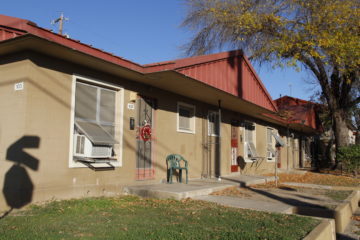
In September, the Alazán-Apache Courts were listed as one of “America’s 11 Most Endangered Historic Places” by the National Trust for Historic Preservation, a D.C.-based nonprofit. San Antonio preservationists, including the Esperanza Peace and Justice Center, which runs a meeting space and arts cooperative next to Alazán-Apache, submitted the nomination for the designation. Esperanza and its allies would like to see the courts rehabilitated and kept largely intact—perhaps using tax credits for historic preservation—rather than demolished and replaced.
In response to the historic recognition, a SAHA spokesperson said that “abject poverty is not a historic designation worth protecting,” adding that the West Side is “on the brink of a revitalization it desperately needs.”
Following the designation, about 80 protesters gathered downtown in November for a demonstration that included a stop outside the lofts where Nisivoccia, SAHA’s outgoing CEO, lives. In response, a SAHA spokesperson called the demonstration “uncivil” and said the agency “[does] not condone protests which jeopardize the safety of our leadership and staff members”—though the San Antonio Heron reported that “at no time did the protest get out of hand or become violent.”
Among current Alazán-Apache residents, opinions about the demolition appear mixed. At recent board meetings, a handful of current tenants have spoken on both sides of the issue. One demolition supporter was María Cruz Vargas, a mother of five who said in Spanish at the October meeting: “I would like the buildings to be torn down and rebuilt because the kitchen and rooms are really, really small, and because the area’s unsafe.” Others cited a cracking foundation, along with drug dealers and homeless individuals in the area, as reasons to redevelop.
Kayla Miranda, an Alazán-Apache resident and leading opponent of demolition, says that when she goes door-to-door, “most people don’t want them demolished because they don’t want to lose their place.” Miranda says that residents are familiar with other public housing projects that SAHA has torn down and the subsequent struggles tenants faced. But, Miranda claims, few tenants want to publicly oppose the redevelopment for fear of crossing their landlord, SAHA.
SAHA itself cites a resident survey the agency conducted of 130 tenants earlier this year as evidence of supermajority support for demolition. In public presentations and statements, SAHA cites a survey question in which 79 percent of respondents said they would prefer the courts be “rebuilt” rather than “remodeled.” But the survey, first published by the Heron, contains confusingly worded questions and contradictory answers. For example, in the question immediately prior to the one that SAHA publicly cites, residents are asked if they are excited about the “remodel,” and 72 percent said yes. The word “demolish” appears just once, in a question about what would make the courts a better place to live, and only 49 percent of residents selected “demolish existing buildings and build new.”
SAHA has a spotty record on similar redevelopment projects. Just seven years ago, the agency tore down the Wheatley Courts on the city’s historically Black East Side and replaced them with mixed-income apartments. Less than a quarter of the families returned. Olga Kauffman—today a SAHA board member who voted against the Alazán demolition application in November—was a case manager working with Wheatley residents at the time. “Some of them ended up . . . in a lot of really bad places, like [the Haven for Hope homeless shelter] or in jail,” she recently told the Heron. That project also had additional federal funding, called a Choice Neighborhood grant, that the Alazán project was denied.
SAHA routinely acknowledges its patchy record. “What happened at Wheatley is not what’s going to happen [now]. … We learned lessons that were very hard,” said SAHA Board Chair Cha Guzman, who was appointed to the role by Mayor Ron Nirenberg in late 2019, during the November board meeting. “This is a new SAHA.”
Meanwhile, SAHA is taking an ever more confrontational approach with certain activists, including making misleading statements. In December, Guzman and Nisivoccia wrote an open letter to Graciela Sánchez, who heads the preservationist Esperanza Peace and Justice Center. In it, the SAHA leaders accuse the Esperanza Center of “hate speech,” saying Esperanza employees called SAHA staff “Gestapo Nazis” and chanted the phrase “housing holocaust.” According to Sánchez, Miranda, and news reports, those phrases were uttered at some point by tenants or activists, but not by Esperanza staff. The letter also accuses Sánchez of living in a different neighborhood than Sánchez says she does and alleges that the “majority” of the Historic Westside Residents Association, the local neighborhood association, are her family members—-a patent falsehood, Sánchez says.
When contacted for comment, Guzman responded with a lengthy email to the Observer and the Texas Democracy Foundation, the publisher of the Observer, of which Guzman’s husband, Gilberto Ocañas, is a former board member. In it, Guzman attacked a previous Observer story about Alazán-Apache by claiming—falsely—that the Observer “only interviewed the main five critics of the agency.” She also accused the Observer of “yellow journalism.”
Guzman did not answer specific questions about the letter to Sánchez, nor did she answer most specific questions about the resident survey. She did, however, list a number of tax-credit mixed-income housing developments being built on the West Side, which she said will be able to “comfortably accommodate” the Alazán-Apache residents during the redevelopment process.
Read more from the Observer:
-
Bringing the Dead Home: Thirty years after Congress passed the Native American Graves Protection and Repatriation Act, only a fraction of human remains held by Texas’ museums and universities have been returned.
-
How We Got Here: Texas’ health system has been underfunded, understaffed, and unprepared for years. Here, COVID-19 found the perfect place to spread.
-
‘Being A Prisoner During COVID Is A Death Sentence’: Death row exoneree Anthony Graves reflects a decade after his release.
